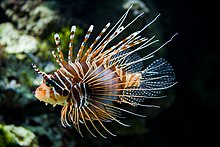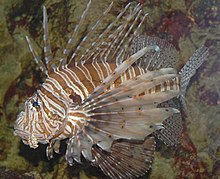Uploaded on Sept. 9, 2010
Local diver invents device to kill "Lion-fish"
rjnjupiter
Pterois, commonly known as Lion-fish, is a genus of venomous marine fish found mostly in the Indo-Pacific. Pterois is characterized by red, white and black bands, showy pectoral fins and venomous spiky fin rays.[1][2]
Pterois are classified into nine different species, but Pterois radiata, Pterois volitans and Pterois miles are the most commonly studied. Pterois are popular aquarium fish and are readily utilized in the culinary world.[1]
In the mid 1990s, the species P. volitans and P. miles were unintentionally introduced into the Atlantic Ocean and have become an invasive species along the East Coast of the United States,[2] the Mesoamerican Barrier Reef System, and the wider Caribbean. They are now also found in the Gulf of Mexico.[3]
| Pterois | |
|---|---|
 |
|
| Pterois antennata | |
| Scientific classification | |
| Kingdom: | Animalia |
| Phylum: | Chordata |
| Class: | Actinopterygii |
| Order: | Scorpaeniformes |
| Family: | Scorpaenidae |
| Subfamily: | Pteroinae |
| Genus: | Pterois Oken, 1817 |
| Species | |
| See text. | |
Description
Pterois range in size from 6.2 to 42.4 cm with typical adults measuring 38 cm and weighing an average of 480 g.[2][4][5] They are well known for their ornate beauty, venomous spines and unique tentacles.[6][7]Juvenile Lion-fish have a unique tentacle located above their eye sockets that varies in phenotype between species.[6] It is suggested that the evolution of this tentacle serves to continually attract new prey; studies also suggest that it plays a role in sexual selection.[6]
Ecology and behavior
Pterois can live from five to fifteen years and have complex courtship and mating behaviors.[8] Females release two mucus-filled egg clusters frequently, which can contain as many as fifteen thousand eggs.[8][9] Studies on Pterois reproductive habits have increased significantly in the past decade.[9]Invasive introduction and range
See also: Pterois volitans and Pterois miles
The red Lion-fish is found off the East Coast of the United States and the Caribbean Sea, and was likely first introduced off the Florida coast in the early to mid-1990s.[25]
It has been speculated that this introduction may have been caused when Hurricane Andrew destroyed an aquarium in southern Florida,[26] It is also believed that six Lion-fish were accidentally released in Biscayne Bay, Florida after Hurricane Andrew in 1992.[27]
However, a more recent report states National Oceanic and Atmospheric Administration (NOAA) ecologist James Morris Jr. has discovered that a Lion-fish was discovered off the coast of south Florida prior to Hurricane Andrew in 1985.[28][29]
It is also believed that the Lion-fish were purposefully discarded by unsatisfied aquarium enthusiasts.[27]
The first documented capture of Lion-fish in the Atlantic occurred in Dania Beach, Florida.[4] In 2001, NOAA documented multiple sightings of Lion-fish off the coast of Florida, Georgia, South Carolina, North Carolina, and Bermuda, and were first detected in the Bahamas in 2004.[30]
Recently (late November 2011) they have been discovered as far east as Barbados,[31] and as far south as Los Roques Archipelago and many Venezuelan continental beaches.[32]

P. volitans comprises the largest part of the invasive Lion-fish population in the Atlantic and Caribbean
Adult Lion-fish specimens are now found along the United States East Coast from Cape Hatteras, North Carolina, to Florida, and in Bermuda, the Bahamas, and throughout the Caribbean, including the Turks and Caicos, Haiti, Cuba, Dominican Republic, Cayman Islands, Aruba, Curacao, Bonaire, Puerto Rico, St. Croix, Belize, Honduras and Mexico.[2]
Population densities continue to increase in the invaded areas, resulting in a population boom of up to 700% in some areas between 2004 and 2008.[33] Population densities have reached levels that are orders of magnitude greater than their native ranges.[34]
Pterois are known for devouring many other aquarium fishes.[27] Pterois are unusual in that they are among the few fish species to successfully establish populations in open marine systems.[35]
Pelagic larval dispersion is assumed to occur through oceanic currents, including the Gulf Stream and the Caribbean Current. It is projected that currents could eventually result in new populations along the Gulf Coast.[36]
Ballast water can also be attributed to the dispersal.[37]
Extreme temperatures present geographical constraints in the distribution of aquatic species,[38] indicating that temperature tolerance plays a role in the Lion-fish’s survival, reproduction and range of distribution.[39]
Observational studies have shown that the abrupt differences in water temperatures north and south of Cape Hatteras directly correlate with the abundance and distribution of Pterois.[38]
Pterois expanded along the entire eastern coast of the United States and occupied thermal-appropriate zones within ten years.[38]
Although the timeline of observations points to the east coast of Florida as the initial source of the western Atlantic invasion, the relationship of the United States East Coast and Bahamian Lion-fish invasion is uncertain.[40]
Control and eradication efforts

P. miles makes up about seven percent of the invasive lionfish population in the Atlantic and Caribbean
The study showed that the most effective way to even maintain current Lion-fish population densities, at least 27% of the invasive adult populations would have to be killed monthly. The fact that Lion-fish are able to reproduce monthly throughout the entire year means that this is an effort that must be maintained monthly for the maintenance of current population densities.[41]
Even to accomplish these numbers seems unlikely, but as populations of Lion-fish continue to grow throughout the Caribbean and Western Atlantic, actions are being taken to attempt to control the quickly growing numbers.
In November 2010, the Florida Keys National Marine Sanctuary began to give out licenses to divers to kill Lion-fish inside of the sanctuary. This is the first time this has ever been done for any species in the sanctuary, in a desperate attempt to eradicate the fish. Rigorous and repeated removal of Lion-fish from invaded waters will be necessary to establish control on the exponentially expanding population.[2]
Many conservation groups across the Eastern United States are organizing hunting expeditions for Pterois. The Environment Education Foundation recently hosted its third ‘Lion-fish derby’ in Florida, offering more than $3,000 in prize money for dive teams catching the most Lion-fish.[42]
Community organizations are forming across the country in hopes of halting the ever expanding Lion-fish population.[42] Dive-masters from Cozumel to the Honduran Bay Islands routinely spear Lion-fish during dives, sometimes killing as many as eight in an hour. Based on average kills per dive, a professional diver could easily kill 3000 to 4000 Lion-fish per year (3 dives per day, 6 days per week, averaging 4+ kills per dive).[citation needed]
Other interest groups, such as NOAA, are setting up events and campaigns that encourage the killing and eating of the fish.[34]
Many people are wary of the idea of eating a venomous fish, but when properly filleted the fish is perfectly healthy to eat. Encouraging the consumption of Lion-fish could not only help to maintain a reasonable population density, but also provide an alternative fishing source to other over fished populations, such as grouper and snapper.
The Reef Environmental Education Foundation has even prepared a cookbook to help educate restaurant chefs on how they can incorporate the fish into their menu. The NOAA calls the Lion-fish a "delicious, delicately flavored fish" similar in texture to grouper.[42] Many recipes for lionfish can be found in coastal cookbooks, some including fried Lion-fish, Lion-fish ceviche, Lion-fish jerky and grilled Lion-fish.[43]
The evasiveness of the red Lion-fish is an extreme problem, and relatively little information is still known about the animal. The NOAA has research foci in place to better understand the fish and the implications surround its invasive nature.
Some of these include investigating biotechnological solutions for control of the population, and understanding how the larvae are dispersed. Another important area of study is how the population is controlled in its native area.
If we find out why it is not out of control in the Indo-Pacific, we may be able to implement a similar concept into the invasive populations, without causing unintended results such as another invasive species. NOAA also plans to further its "Lion-fish as Food" campaign, as human hunting of the fish is the only known current form of control. The NOAA also encourages people to report Lion-fish sightings to help keep a better record of dispersal.[44]
Long term effects of invasion
Lion-fish have successfully pioneered the coastal waters of the Atlantic in less than a decade and pose a major threat to reef ecological systems in these areas.A study published in 2006 comparing their abundance from Florida to North Carolina with several species of groupers found that they were second only to the native scamp grouper and equally abundant to the graysby, gag, and rock hind.[2]
This could be due to a surplus of resource availability resulting from the over-fishing of Lion-fish predators like grouper.[45]
Although the Lion-fish has not expanded to a population size that is currently causing major ecological problems, their invasion in the United States coastal waters could lead to serious problems in the future.
One likely ecological impact caused by Pterois could be their impact on prey population numbers by directly affecting food web relationships. This could ultimately lead to reef deterioration and could negatively influence Atlantic trophic cascade.[8]
It has already been shown that Lion-fish overpopulate reef areas and display aggressive tendencies; forcing native species to move to waters where conditions might be less than desirable.[2]
Studies show that Lion-fish could be decreasing Atlantic reef diversity by up to 80%.[23] In July 2011, Lion-fish were reported for the first time in the Flower Garden Banks National Marine Sanctuary off the coast of Louisiana.[46]
Sanctuary officials said they believe the species will be a permanent fixture, but hope to monitor and possibly limit their presence.
Source: Wikipedia.org
Somebody Come and Play in Traffic with Me! Earn as You Learn, Grow as You Go!
The Man Inside the Man
from
Sinbad the Sailor Man
A
JMK's Production
Share this page, If you liked It Pass it on, If you loved It Follow Me!
TTFN
CYA Later Taters!
Thanks for watching.
Donnie/ Sinbad the Sailor Man
Somebody Come and Play in "Traffic" with me. If you would like to "Join" A Growing Biz Op! Here is Your Chance to get in an Earn While You Learn to Do "The Thing" with us all here at Traffic Authority.
Simply click this link and Grow as you Go Come and Play In Traffic With Me and My Team at Traffic Authority!
Simply click this link and Grow as you Go Come and Play In Traffic With Me and My Team at Traffic Authority!
P.S. Everybody Needs Traffic! Get Top Tier North American Traffic Here!


No comments:
Post a Comment